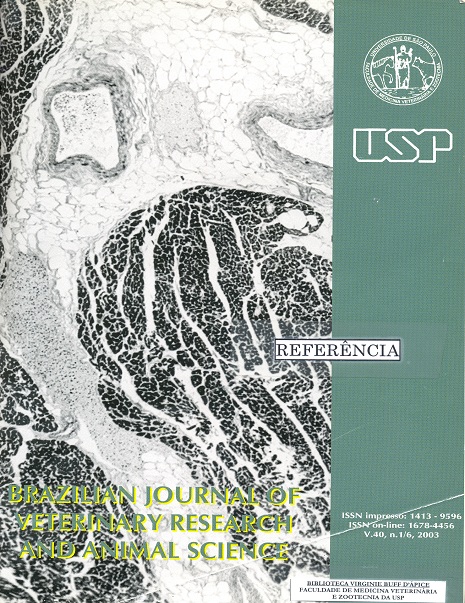Frequency of IgG antibodies against-Toxoplasma gondii in sera of stray dogs in the city of Salvador-Bahia, Brazil
DOI:
https://doi.org/10.1590/S1413-95962003000600010Keywords:
Toxoplasma gondii, Dogs Indirect fluorescence antibody, FrequencyAbstract
The Toxoplasma gondii is an obligate intestinal intracelular coccidian protozoan of felidae, being considered cosmopolitan, discovered in 1908 by Nicolle & Manceaux. The first report in the canine species happened in 1910, in Italy and, in Brazil in 1911. With the objective of evaluating the frequency of this parasite in the population of dogs of the city of Salvador-Ba, 225 samples of blood from animals of 10 sanitary districts were collected for the accomplishment of the reaction of indirect fluorescent antibody (IFA) for detection of IgG antibodies against-Toxoplasma gondii, using the strain AS28. 143 positive samples were detected, representing a frequency of 63.55.00%. The frequencies for sanitary districts were distributed as follow: Itapagipe 33.33%; São Caetano/Valéria 46.15.00%; Brotas 42.11%; Barra/Rio Vermelho 64.28%; Boca do Rio 80.00%; Itapuã 65.38%; Cabula/Beiru 80.64%; Pau da Lima 73.91%; Cajazeiras 64.70.00% e Subúrbio Ferroviário 73.33%. The serum titers found ranged from 1:16 to 1:16384, being 1:16 (28.67%), 1:64 (44.76%), 1:256 (21.68%), 1:1024 (4.20%) and 1:16384 (0.70.00%). Of the 123 males and 102 females, 67.48% and 58.82% were positive, respectively. Concerned to the age, of the 198 adults and 27 youngs, 70,20% and 14,80% were positive, respectively. The age and sanitary districts presented significant statistical result (p<0,05).Downloads
Download data is not yet available.
Downloads
Published
2003-01-01
Issue
Section
UNDEFINIED
License
The journal content is authorized under the Creative Commons BY-NC-SA license (summary of the license: https://
How to Cite
1.
Barbosa MVF, Guimarães JE, Almeida M Ângela O, Gondim LFP, Regis GB. Frequency of IgG antibodies against-Toxoplasma gondii in sera of stray dogs in the city of Salvador-Bahia, Brazil. Braz. J. Vet. Res. Anim. Sci. [Internet]. 2003 Jan. 1 [cited 2026 Jan. 18];40(6):457-65. Available from: https://revistas.usp.br/bjvras/article/view/11301





